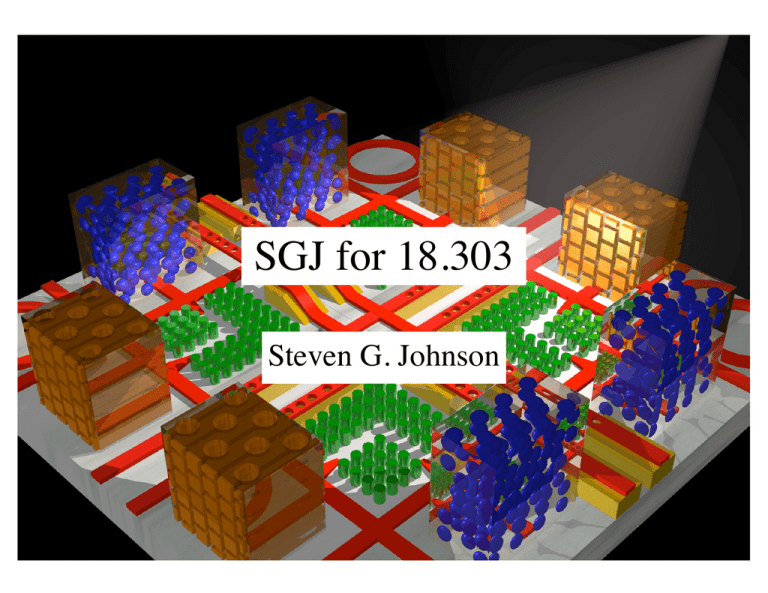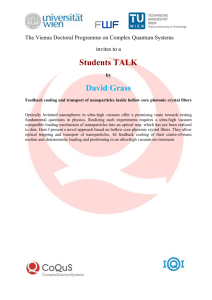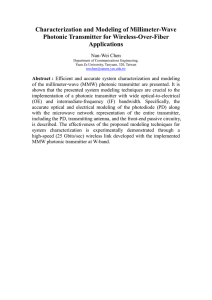Document 10605449
advertisement

SGJ for 18.303 Steven G. Johnson Photonics classical electromagnetic effects can be altered by λ-scale structures optical insulators Cregan (1999) [ D. Norris, UMN (2001) ] trapping/guiding light in vacuum high-quality µ-resonances coupled to other physics (e.g. vibration) [ Eichenfield et al. Nature Photonics 1, 416 (2007) ] Instead of finding new materials, one tries to find new geometries = new effects. [ Schliesser et al., PRL 97, 243905 (2006) ] Mathematical challenges for lengthscales a ~ wavelength λ • Complete analytical solutions are almost never possible, so how do we understand waves in complex geometries? … theorems, conservation laws, perturbatively, … • What new phenomena are possible that wouldn t happen in homogeneous media, ray optics (a>>λ), or circuits (a<<λ) • How do we design new/better optical devices (solar, lasers, fibers, …) exploiting so many degrees of freedom? Complex geometries = messy results? here: scattering off three specks of silicon can be solved on a computer, but not terribly interesting… An even bigger mess? zillons of scatterers Blech, light will just scatter like crazy and go all over the place … how boring! Fun with Math ! ! 1$ ! % ! !"E =# H =i H c $t c ! ! 1 $ ! ! 0 % ! !"H =& E + J = #i &E c $t c First task: get rid of this mess dielectric function ε(x) = n2(x) ! %$( ! 1 !" !"H =' * H & c) # 2 eigen-operator eigen-value + constraint ! !"H = 0 eigen-state Hermitian Eigenproblems ! %$( ! 1 !" !"H =' * H & c) # 2 eigen-operator eigen-value + constraint ! !"H = 0 eigen-state Hermitian positive semi-definite for real (lossless) ε>0 well-known properties from linear algebra: ω are real (lossless) eigenfunctions are orthogonal usually diagonalizable (eigenbasis) …the magic of symmetry… Noether s theorem: symmetry = conservation laws [ Emmy Noether, 1915 ] In this case, periodicity = conserved momentum = wave solutions without scattering [ Bloch waves ] Felix Bloch (1928) Periodic Hermitian Eigenproblems [ G. Floquet, Sur les équations différentielles linéaries à coefficients périodiques, Ann. École Norm. Sup. 12, 47–88 (1883). ] [ F. Bloch, Über die quantenmechanik der electronen in kristallgittern, Z. Physik 52, 555–600 (1928). ] if eigen-operator is periodic, then Bloch-Floquet theorem applies: can choose: ! ! ! ! ! i ( k ! x "# t ) ! H ( x,t) = e H k! ( x) planewave periodic envelope Corollary 1: k is conserved, i.e. no scattering of Bloch wave ! Corollary 2: H k! given by finite unit cell, so ω are discrete bands ωn(k) Electronic and Photonic Band Structures dielectric spheres, diamond lattice wavevector strongly interacting fermions photon frequency electron energy Bloch waves: Band Diagram Periodic Medium atoms in diamond structure wavevector weakly-interacting bosons Not so messy, not so boring… the light seems to form several coherent beams that propagate without scattering … and almost without diffraction (supercollimation) A slight change? Shrink λ by 20% an optical insulator (photonic bandgap) light cannot penetrate the structure at this wavelength! all of the scattering destructively interferes Photonic Crystals in Nature Morpho rhetenor butterfly Peacock feather http://www.bugguy012002.com/MORPHIDAE.html wing scale: [ P. Vukosic et al., Proc. Roy. Soc: Bio. Sci. 266, 1403 (1999) ] 3µm [ also: B. Gralak et al., Opt. Express 9, 567 (2001) ] [J. Zi et al, Proc. Nat. Acad. Sci. USA, 100, 12576 (2003) ] [figs: Blau, Physics Today 57, 18 (2004)] A Synthetic Opal colloid: suspension of microparticles in fluid particles close-pack after fluid evaporates [ fig courtesy D. Norris, UMN ] Inverse-Opal Photonic Crystal[ fig courtesy (because opal alone has no band gap) D. Norris, UMN ] sub-micron colloidal spheres Template (synthetic opal) 3D Infiltration Remove Template Inverted Opal [ Y. A. Vlasov et al., Nature 414, 289 (2001). ] Fabrication by Lithography [ K. Ho et al., Solid State Comm. 89, 413 (1994) ] (4 log layers = 1 period) Si http://www.sandia.gov/media/photonic.htm Woodpile crystal [ H. S. Sözüer et al., J. Mod. Opt. 41, 231 (1994) ] [ S. Y. Lin et al., Nature 394, 251 (1998) ] gap Intentional defects are good! periodic electromagnetic media can trap light cavities 3D Photonic C rystain l with Defects and waveguides ( wires ) with photonic band gaps: optical insulators for holding and controlling light Dielectric microcavities Bloch waves in perfect crystal: multiply by exponential decay Ez: shrunk rod enlarged rod Even Stronger Confinement: Topology Optimization Let every pixel be a degree of freedom … Computer searches for best structure (tightest confinement) by large-scale optimization in-plane out-of-plane field E field (broken (rot.symmetry) symmetry) startingEstructure: crystal + defect Waveguides guided by photonic bandgap vs. standard optical fiber: total internal reflection — requires higher-index core no hollow core! hollow = lower absorption, lower nonlinearities, higher power Waveguides + Cavities = Devices waveguide 1 Coupler Channel-drop filter waveguide 2 (mirror plane) [ S. Fan et al., Phys. Rev. Lett. 80, 960 (1998) ] How else can we confine light? Total Internal Reflection no ni > no rays at shallow angles > θc are totally reflected sinθc = no / ni Snell s Law: ni sinθi = no sinθo θo < 1, so θc is real θi i.e. TIR can only guide within higher index unlike a band gap Total Internal Reflection? no ni > no rays at shallow angles > θc are totally reflected So, for example, a discontiguous structure can t possibly guide by TIR… the rays can t stay inside! Total Internal Reflection? no ni > no rays at shallow angles > θc are totally reflected So, for example, a discontiguous structure can t possibly guide by TIR… or can it? Total Internal Reflection Redux no ni > no ray-optics picture is invalid on λ scale (neglects coherence, near field…) translational symmetry Snell s Law is really conservation of k|| and ω: |ki| sinθi = |ko| sinθo |k| = nω/c (wavevector) (frequency) θi k|| θo conserved! Photonic-Crystal Slabs 2d photonic bandgap + vertical index guiding [ S. G. Johnson and J. D. Joannopoulos, Photonic Crystals: The Road from Theory to Practice ] An Experimental (Laser) Cavity [ M. Loncar et al., Appl. Phys. Lett. 81, 2680 (2002) ] cavity (InGaAsP) Molding Diffraction for Lighting [ another MIT startup (by a colleague): Luminus.com ] ultra-bright/efficient LEDs periodic pattern gathers & redirects it in one direction new projection TVs, pocket projectors, lighting applications, … Another 2d-to-3d route: Fibers Traditional silica fibers: amazingly good more complex profiles (~100km decay length) to tune dispersion … high index but hard to make doped-silica core significantly better n ~ 1.46 or work in new regimes without going to LP01 radically new designs confined mode silica cladding field diameter ~ 8µm n ~ 1.45 protective polymer sheath [ R. Ramaswami & K. N. Sivarajan, Optical Networks: A Practical Perspective ] Index-Guiding PCF & microstructured fiber: Holey Fibers solid core holey cladding forms effective low-index material Can have much higher contrast than doped silica… strong confinement = enhanced nonlinearities, birefringence, … [ J. C. Knight et al., Opt. Lett. 21, 1547 (1996) ] Nonlinear Holey Fibers: Supercontinuum Generation (enhanced by strong confinement + unusual dispersion) e.g. 400–1600nm white light: from 850nm ~200 fs pulses (4 nJ) [ figs: W. J. Wadsworth et al., J. Opt. Soc. Am. B 19, 2148 (2002) ] [ earlier work: J. K. Ranka et al., Opt. Lett. 25, 25 (2000) ] Breaking the Glass Ceiling: Hollow-core Bandgap Fibers 1000x better Bragg fiber loss/nonlinear limits [ Yeh et al., 1978 ] (from density) 1d crystal + omnidirectional = OmniGuides 2d crystal Photonic Crystal PCF [ Knight et al., 1998 ] Breaking the Glass Ceiling: Hollow-core Bandgap Fibers Bragg fiber [ Yeh et al., 1978 ] [ figs courtesy Y. Fink et al., MIT ] white/grey = chalco/polymer + omnidirectional = OmniGuide fibers silica [ R. F. Cregan et al., Science 285, 1537 (1999) ] 5µm PCF [ Knight et al., 1998 ] Experimental Air-guiding PCF Fabrication (e.g.) silica glass tube (cm s) (outer cladding) ~50 µm fiber draw ~1 mm fuse & draw Experimental Air-guiding PCF al.,Science OFC 285, 20041537 PDP24 [ R.[Mangan, F. Cregan etetal., (1999)] ] 10µm 5µm a later/better fabrication A Cylindrical Bandgap Fiber [ figs courtesy Y. Fink et al., MIT ] white/grey = chalco/polymer High-Power Fibers at New λ s CO laser: λ=10.6µm (no previous dielectric waveguide) 2 Polymer losses @10.6µm ~ 50,000dB/m… …waveguide losses < 1dB/m Application: Laser surgery [ www.omni-guide.com ] [ B. Temelkuran et al., Nature 420, 650 (2002) ] Electromagnetic Fluctuations All matter is filled with constantly fluctuating current sources… … radiating photons = fluctuating fields everywhere at all frequencies [ even at zero temperature due to quantum effects ] causing nearby matter to interact van der Waals Forces Attractive forces between otherwise neutral atoms thermal/quantum fluctuating dipole: induced dipole + + + + + – – – – – p1 p2 d van der Waals (London dispersion) force [1930] (close proximity) 1 U~! 6 d 1 F ~! 7 d van der Waals Forces: Approximations • Small separations only (e.g. < 10s of nm) = neglect wave effects • Dilute / weakly-polarizable only = neglect multiple scattering Casimir Effect macroscopic objects (many interacting dipoles) E d Electromagnetic field must satisfy boundary conditions at material interfaces ⇒ designable fluctuations Hendrik Casimir (1948) perfect metal plates d !c" 2 F /A = ! 240d 4 attractive, monotonically decreasing pressure ~ 1 atm at d=50nm Experiments • Van Blockland, Overbeek 1978 first clear qualitative observation Applications micromechanical/fluidic devices • Lamoreaux 1997 – first high-precision • Many, many experiments since … [U. Mohideen et. al. PRL, 81 (1998)] Casimir ⇒ e.g. stiction problems [Chan et. al., Science 91, (2001)] study complicated geometries: reduce stiction? new effects? how much can we design the force? Selected pre-2007 Casimir theory 1950 Casimir force between plates 1960 Stress-tensor method for dielectric slabs 2006 Various perturbative methods developed perfect-metal plates [Casimir, H. B. G, Acta. Phys. (1948)] 2003 2000 1970 Cylinder-plate for perfect metals Casimir pistons multi-layer generalizations [ Hertzberg, Cavalcanti (2004), Kardar, Jaffe, and others ] corrugated plates [Emig, Kardar. et. al., PRL 87, 260402 (2001)] cylinder-plate [Emig, Jaffe, Kardar, Scardicchio PRL 96, 080403 (2006)] How can this be problem be so hard? non-interacting bosons — linear Maxwell-like PDEs, continuum material models polynomial complexity • Solution can easily involve solving PDE s at least 1000 s of times (or much more!) • Which PDE you solve makes a huge difference — many equivalent formulations … which are well suited for numerics? Lots of tricks: good basis choices, connection to Green s functions, rotation to imaginary frequencies, integral equations, … 1st repulsive geometry in vacuum [ Levin et al, PRL (2010) ] force simple: an elongated needle above a metal plate with a hole (related classical phenomena) [ Levin & Johnson, arXiv:1007.2175 (2010), Am. J. Phys. 79, 843 (2011) ] a point charge near a neutral metallic shape is normally attracted … just by changing the shape, can we make them repel? (related classical phenomena) [ Levin & Johnson, arXiv:1007.2175 (2010), Am. J. Phys. 79, 843 (2011) ] force less obvious analogues… force pushing current away pulling current towards from decreased resistivity increased resistivity neutral metallic shapes that repel a point charge or a dipole (…all just Poisson s equation) finis A well-known PDE in complex circumstances can produce surprising results. There is more to learn in electromagnetism than what is covered in 8.02, or was known to Maxwell in 1865! Happy holidays! Free Materials Online Photonic Crystals book: jdj.mit.edu/book Tutorial slides: jdj.mit.edu/photons/tutorial Free electromagnetic simulation software (FDTD, mode solver, etc.) jdj.mit.edu/wiki MIT graduate course 18.369 materials math.mit.edu/~stevenj/18.369





